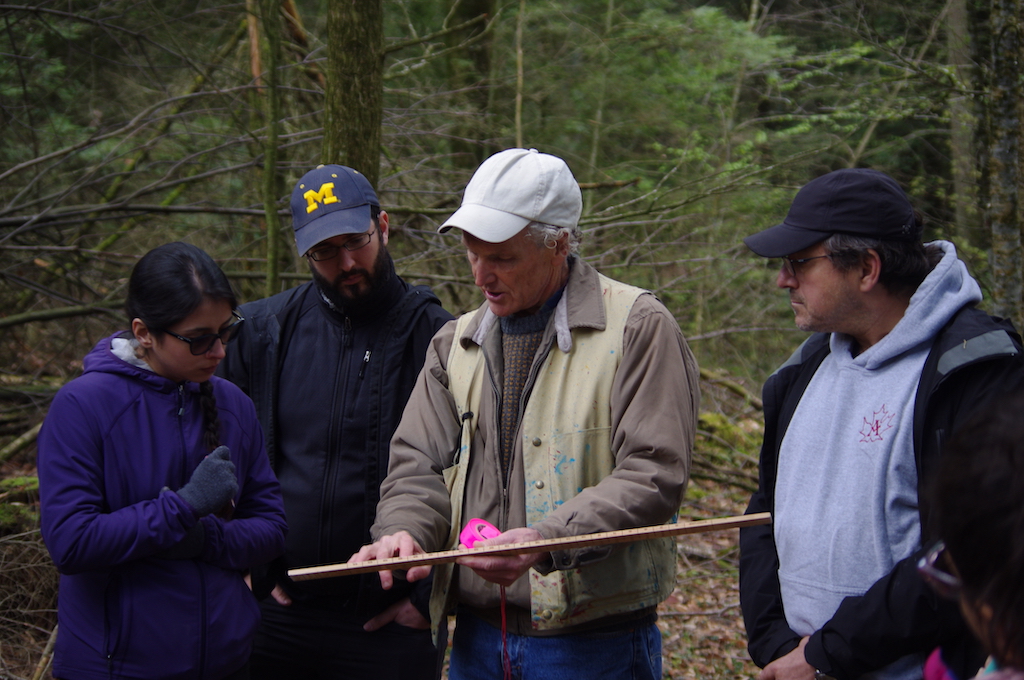
A Legacy Visit from Quebec Conservationists
by David Brynn
Vermont Family Forests recently had the distinct honor to host a group of forest conservationists from the University of Quebec Montreal (UQAM). Under the leadership of Dr. Christian Messier, these bright young people from across the border and planet are looking at new relationships with forests. A focus of their work is to imagine a new silviculture that focuses on forest ecosystem adaptation and complexity rather than forest resource management and wise use.
Their Vermont visit came out of a series of steps that resulted from the publication in 2018 of the tenth edition of The Practice of Silviculture: Applied Forest Ecology. In that text, which is the very foundation of forestry, the authors stated that, within the past twenty years, many new theories have been advanced in “applying silvicultural treatments judiciously based on ecology.” One reference cited was entitled A Critique of Silviculture: Managing for Complexity,authored by K.J. Puettmann, K.D. Coates, and C.C. Messier in 2012. This little book, published by Island Press ,includes some the most inspiring new thinking regarding the practice of forestry since Aldo Leopold’s A Sand County Almanacwas published in 1946. One of the co-authors, Christian Messier, who teachers and researches at UQAM, welcomed a visit. We met in Montreal, immediately hit it off, and imagined a two-day Vermont visit.
Our guests were a truly inspiring, curious, and inquisitive group of young men and women doing masters, doctorate, and post-doctoral work in conservation biology, urban forestry, forest resilience, socio-ecological factors of sustainable forest management, insect ecology, and management of deciduous forests. They hail from Quebec, France, Costa-Rica, Germany, Italy, and Colombia, so we truly had global perspectives on forests and forestry.

We started with a visit to the lands of the Watershed Center located on Plank Road in Bristol. This 1001-acre jewel has been actively managed and conserved (with a focus on complexity without actually using the term) through Vermont Family Forests since 1998. Eric Sorenson and Jim Andrews participated in the walk and talk. Eric outlined the role of the Vermont Fish &Wildlife Department’sVermont Conservation Design in conserving a healthy, productive, complex landscape that provides for human socio-economic needs while conserving key ecological functions and values over time and space. Jim Andrews, principal behind the Vermont Reptile and Amphibian Atlas, described the how the Atlas is being generated and applied in conserving Vermont’s reptile and amphibian populations. These and all of the conversations throughout the visit were in the context of a rapidly changing climate.
That evening we met at the Middle Barn of VFF’s Anderson Wells Farm in Lincoln. Despite the cold, we warmed the barn with festivities, as about forty hardy souls gathered to celebrate our northern visitors—including many of the wonderful Middlebury College senior seminar students we’ve had the pleasure of working with over the spring term, as well as many of the dedicated local folk who work on behalf of forests in our region. We fired up the pizza oven, sipped local brews, and topped off the evening with stories from master storyteller and woodsman Bill Torrey.

The second day we met on the Bristol green to learn about Vermont’s Urban and Community Forestry Program from Joanne Garton. Sitting in the gazebo surrounded by lovely shade trees in the early morning sun, it was easy to sense that we live in paradise and hard to imagine that anything could be amiss in our idyllic landscape. But as we discussed both here in the Bristol green and out in the forests we visited, Vermont’s trees and forests face immense and imminent changes, from emerald ash borer to climate change. Complexity is the key to resilience. The Bristol green reflects complexity in the diversity of trees our town opted to plant over the years. Because of that only one of those trees, a green ash, will succumb to emerald ash borer.
We next headed out for a brief visit at Ron and Karen McEachen’s family forest to see what an actively managed forest looks like after nearly three decades of VFF’s style of forestry. The McEachen woods had a series of trails that we call lines of grace. Their woods has provided timber for several building projects at Shelburne Museum, Middlebury College and the Green Mountain Club, as well as many of the Lake Champlain Maritime Museum’s longboats. Ron McEachen and Bill Torrey, Vermont’s premier logger and story teller, have worked well together over the years to produce an exceptionally beautiful, healthy, and productive forest using small-scale forwarding equipment and careful directional felling.

The final visit of the day was at the Little Hogback Community Forest (LHCF) located on Hardscrabble Road in Monkton. Led by shareholders John McNerney and Don Dewees, the group explored the innovative structure of LHCF, which was imagined and manifested by Deb Brighton of Salisbury, Vermont, longtime member of VFF’s board of directors. Conserved through the Vermont Land Trust and jointly owned by 16 families, an affordability covenant was added to allow some of the sixteen shares to be affordable for lower income folks. The LHCF visit provided insights into the dynamics of a diverse group of shareholders meeting individual needs such as firewood and recreation while providing a host of community benefits including complex wildlife habitat, water quality, flood resilience, and fuelwood for the Monkton community wood bank.
The UQAM visit provided an opportunity to explore Vermont’s emerging Center-West Ecoregion and to imagine a sister ecoregion north of the border. One that comes to mind is in the eastern townships, where the forest cover type is similar to ours and the rolling hills and villages, centered around Sherbrooke, hold much in common with our own. Many thanks to Christian Messier and his students for an inspiring visit.






